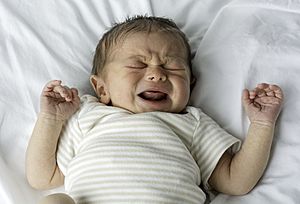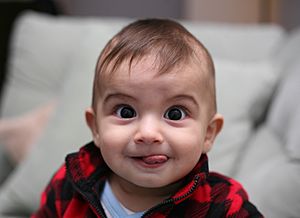Baby facts for kids
A baby is a very young human who is born when a mother gives birth. Babies are also called infants during their earliest stage of life. Some people use the word "infant" for babies until they can walk, while others use it for babies under one year old. A baby less than one month old is called a newborn. The word infant comes from Latin, meaning "unable to speak."
After learning to walk, infants are often called toddlers, usually when they are between one and three years old.
Contents
Understanding Newborn Babies
Newborn babies have some special features that make them unique. Here's a look at some of them.
Newborn Weight and Growth
In many developed countries, a full-term newborn baby usually weighs about 3.4 kilograms (7.5 pounds). Their weight typically ranges from 2.7 to 4.6 kilograms (6 to 10 pounds).
During the first week after birth, a baby's weight might slightly decrease. This happens because they lose some fluid that was in their lungs. After the first week, healthy babies usually start gaining weight quickly, about 10 to 20 grams (0.35 to 0.7 ounces) each day.
A Baby's Head and Skull
A newborn baby's head is quite large compared to the rest of their body. The top part of their skull is also very big compared to their face. While an adult's skull is about one-seventh of their total body length, a newborn's skull is about one-fourth of their length.
When a baby is born, some parts of their skull haven't fully turned into bone yet. These are called "soft spots" or fontanels. The two largest soft spots are on the top front and back of the head. These bones will naturally join together as the child grows older.
During the process of birth, a baby's skull can change shape slightly to fit through the mother's birth path. This might make the baby's head look a bit different at first, but it usually returns to its normal shape within a few days or weeks.
Baby Hair and Skin
Some newborns have very fine, soft body hair called lanugo. You might see it on their back, shoulders, forehead, or ears, especially if they were born a bit early. This lanugo usually disappears within a few weeks.
Babies can be born with a lot of hair on their head, while others might have very fine hair or even be bald. For babies with fair-skinned parents, this fine hair might be blonde, even if the parents have darker hair.
Right after birth, a newborn's skin might look grayish or bluish. But as soon as they start breathing, usually within a minute or two, their skin color returns to normal.
The Umbilical Cord
The umbilical cord of a newborn baby is a bluish-white color. After birth, the umbilical cord is usually cut, leaving a small stub about 1 to 2 inches long. This stub will dry out, shrink, get darker, and then fall off on its own within about three weeks. This spot will later become the baby's belly button.
Caring for and Feeding Babies
Babies cry as a way to communicate their needs. A crying baby might be trying to tell you they are hungry, uncomfortable, too excited, bored, want something, or feel lonely.
Feeding a Baby
Breastfeeding (feeding a baby with milk from the mother's body) is often recommended. Getting enough food when they are very young is super important for a baby's growth. From birth to about four months, babies should have breast milk or a special milk substitute called formula.
As babies get older, new foods are slowly added to their diet. Many parents choose ready-made baby foods to give along with breast milk or formula. Other parents prepare their own meals to be suitable for their child's needs. Whole cow's milk can be given to babies after they turn one year old. However, lower-fat milk should wait until the child is two or three years old.
Weaning is the process where babies slowly stop drinking breast milk and start eating more solid foods instead.
Diapers and Sleep
Until they learn to use the toilet, babies in many countries wear diapers. Learning to go from diapers to regular underwear is a big step in a baby's development towards becoming a toddler.
Children need more sleep than adults. Newborn babies can sleep up to 18 hours a day, and this amount slowly decreases as they get older. Before babies learn to walk, they are carried in arms, slings, or special baby carriers. They can also be moved around in baby carriages or strollers. Most developed countries have laws that require special child safety seats for babies when they are in cars.
The Importance of Touch for Babies

Studies show that babies who experience a lot of positive touch, like stroking or cuddling, develop better emotionally and socially. In experiments, babies who received positive touch cried less often and smiled and made sounds more than babies who were touched negatively (like poking or pinching). Negative touching has been linked to emotional and behavior problems later in life. In cultures where people have more positive physical touch, there tends to be less physical violence among adults.
Human babies have a strong natural need to be held close. They need constant physical contact for their first few weeks or months of life. They are born with special reflexes that help them hold on tightly. These include the Moro reflex (a startle reflex) and an instinctive grasp when a finger or object is placed in their palm.
A baby's legs often naturally rest in an "M" shape, with their knees being the top points of the "M." This position is good for their hip development and also makes it comfortable for an adult to carry them on their chest. Babies also need frequent care because they need to eat and get rid of waste more often than other young animals that stay in nests.
Images for kids
-
A newborn baby, seconds after delivery. Fluid glistens on her skin, and the umbilical cord is still attached.
-
Eight-month-old twin sisters.
-
A mother wishes joy towards her child in William Blake's poem "Infant Joy". This copy was printed and painted in 1826.
-
An East Asian baby.
-
An African baby.
-
An Indian baby.
See also
 In Spanish: Bebé para niños
In Spanish: Bebé para niños













